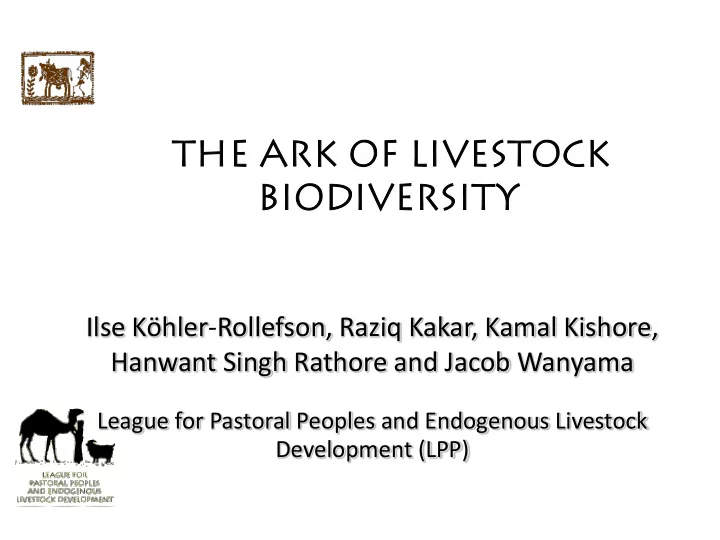

The Ar Ark of Li f Livestock stock Biodive iversi rsity Ilse Köhler-Rollefson, Raziq Kakar, Kamal Kishore, Hanwant Singh Rathore and Jacob Wanyama League for Pastoral Peoples and Endogenous Livestock Development (LPP)
Introduction LPP is an advocacy and technical support organisation for pastoralism and sustainable livestock development, based in Germany and India www.pastoralpeoples.org LIFE-Network for community-based conservation of indigenous livestock breeds, advocating for „Livestock Keepers ‘ Rights “
Two models of livestock production (simplified) Low input, multi-purpose, High input, specialised decentralised Financial investment Locally housing adapted breeds Genetics energy Local Human vegetation care High Concentrate additives feed Ecological, output sustainable output
Threat to livestock biodiversity • As industrial modes of livestock production are spreading around the world, domestic animal diversity is in rapid decline. • According to the FAO, one third of all livestock breeds have either perished or are threatened with extinction.
Domestic Animal Diversity Livestock breed diversity is very high in • pastoralist areas, according to a study conducted in the 1990s (Hall and Ruan) Every pastoralist group has developed ist own • distinct breed (e.g. Boran cattle, Mashona cattle, Nguni cattle, Gaddi goat, Somali and Red Maasai sheep). These breeds are repositories of very important • genes (for disease resistance, hardiness,fertility, etc.)
The livestock of pastoralists • walk for miles in harsh terrain to seek out scattered, spiky, fibrous plants that survive in areas where crops could never be grown. • take droughts and hunger in their stride and act as insurance • are social animals in the true sense – living in a herd, responding to the voice of their keepers, and defending their young against predators. • are part and parcel of their respective eco-systems and provide a host of environmental services
Means of utilizing remote areas
Ability to roam far from water resources prevents overgrazing
Seed scarification
Seed taxi
Questions • How can pastoralists be supported and incentivized to continue their role as stewards of much of the world’s remaining livestock biodiversity? • How can governments and the public realize and become aware of the value of these ecological livestock production systems?
Project: „ From Biocultural Protocols to the Ark of Livestock Biodiversity “ • Supported by the Fondation d‘Entreprise Hermes • In collaboration with LIFE Network
Research Questions • What are the traditional livestock products and what are the traditional processing methods? • What are the special properties of these products in terms of sensory qualities, nutritional value, and medicinal effects? • How can we communicate the special properties of these products? • How can we develop value chains for pastoralist specialty products? • Is there scope for developing a special brand or label that indicates to consumers that a product is from a locally adapted livestock breeds and derives from biodiversity conserving production systems (“Ark of livestock biodiversity”)?
Assumptions Local livestock breeds raised on local resources and as part of the eco-system have the potential for specialty and niche products with health enhancing qualities, heritage value and attractive sensory characteristics.
Nutritional value of livestock products from biodiverse production systems versus soybean/corn diet • Pasture-raised foods have higher levels of vitamins, a healthier balance of omega-3 and omega-6 fats than conventional meat and dairy products. • Milk from pasture-fed cows has as much as five times the Conjugated Linoleic Acid (CLA)as milk from grain- fed cows. • Meat from pasture-fed cows has 200-500% more CLA as a proportion of total fatty acids than meat from cows that eat a primarily grain-based diet. Iv • Eggs from poultry raised on pasture have 40% more vitamin A and 400% more omega-3's.
Methods • Participatory community surveys to identify and document traditional livestock products and processing methods, • analysis of the special properties of these products in terms of sensory qualities, nutritional value, and medicinal effects in collaboration with scientists • sharing of the results with communities, private enterprise and policy makers.
Focus on three communities • Camel breeders in Rajasthan (India) • Pashtoon in Pakistan • Samburu in Northern Kenya
Raika pastoralists of Rajasthan
Samburu pastoralists in Kenya
Pashtoon Pastoralists of Pakistan
Biocultural Protocols • Tool for claiming status as „ indigenous or local community ….“ embodying traditional lifestyles relevant for the conservation and sustainable use of biological diversity ” under Paragraph 8j of the Convention on Biological Diversity (CBD). • Biocultural Protocols document the role of a community in conserving animal genetic resources and eco-systems, contribute to visibility and awareness
Camels in Rajasthan utilize 32 forage species according to local knowledge
Nutritional Value 36 Camel forage plants: most of them have medicinal value
Making ghee
Jaisalmer Ghee THE PREPARATION 6
Results • According to local knowledge, there is a connection between the dietary composition of livestock feed and the nutritional and sensory value of livestock products. • Anecdotal evidence suggests that the diet of pastoralists may be much healthier than that of many urban dwellers. • The methodology of scientifically analysing and validating the nutritional value of the products derived from livestock kept on natural and bio-diverse vegetation versus animals fed with concentrate need to be developed, improved and standardized.
Results • The products from local breeds kept in bio-diverse husbandry systems would be likely to easily find a market among health-conscious urban people and such products could command premium prices. • However, the marketable surplus may be very small and not sufficient to build up economically viable value chains. “In order to eat well, you have to either be a pastoralist or live in a pastoralist area”.
Conclusion • The feasibility of a special label for products from bio- diverse production systems will need further thought and investigation. • But: Local breeds form the foundation for sustainable “ green” livestock development – Do not depend on high inputs of concentrate – make optimal use of local resources and marginal areas – can be kept in systems that are compatible with notions of animal welfare – represent “natural livestock production.
Thank you !
Recommend
More recommend